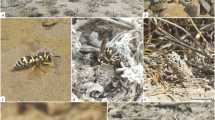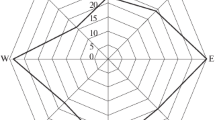Summary
We studied nesting behavior of pine snakes Pituophis melanoleucus from 1977 to 1989. Female pine snakes in the New Jersey Pine Barrens excavate tunnels and a nest chamber for egg deposition. Over 70% of all nests had old, hatched shells remaining in the nests from previous years. The presence of hatched shells and the incidence of recaptured females in the same nest indicates nest site tenacity for some females. From 1977 to 1988 we branded 98 females and 45 were recaptured in the same general nesting area. All 45 recaptured females were recaptured one to four times at the same nest site; two of these snakes were captured in three years at the same site and in one year at a different site. We conclude that females show a high degree of nest site philopatry. We suggest that high nest site philopatry is selected for because it promotes location of sites that are safe from predators (buried, hatched shells) and contain suitable temperature conditions.
Similar content being viewed by others
References
Blem CR (1982) Biennial reproduction in snakes: an alternative hypothesis. Copeia 1982:961–963
Brown WS, Parker WS (1976) Movement ecology of Coluber constrictor near communal hibernacula. Copeia 1976:225–242
Buechner HK, Roth HD (1974) The lek system of the Uganda kob antelope. Am Zool 14:145–162
Bull JJ (1980) Sex determination in reptiles. Q Rev Biol 55:4–21
Bull JJ (1985) Sex ratio and nest temperature in turtles: comparing field and laboratory data. Ecology 66:111–522
Burger J (1977) Determinants of hatching success in diamond-backed terrapin, Malaclemys terrapin. Am Midl Nat 97:444–464
Burger J (1984) Colony stability in least terns. Condor 86:61–67
Burger J (1989) Incubation temperature has long term effects on behavior of young pine snakes. Behav Ecol Sociobiol 24:201–207
Burger J (1991) Effects of incubation temperature on behavior of hatching pine snakes: implications for reptilian evolution. Behav Ecol Sociobiol 28:297–303
Burger J, Zappalorti RT (1986) Nest site selection by pine snakes, Pituophis melanoleucus, in the New Jersey pine barrens. Copeia 1986:116–121
Burger J, Zappalorti RT (1988) Effects of incubation temperature on sex ratios in pine snakes: differential vulnerability of males and females. Am Nat 132:492–505
Burger J, Zappalorti RT (1991) Nesting behavior of pine snakes (Pituophis m. melanoleucus) in the New Jersey Pine Barrens. J Herpetol 25:152–160
Burger J, Zappalorti RT, Gochfeld M, Boarman WI, Caffrey M, Doig V, Garber SD, Lauro B, Mikovsky M, Salina C, Saliva J (1988) Hibernacula and summer den sites of pine snakes (Pituophis melanoleucus) in the New Jersey Pine Barrens. J Herpertol 22:425–433
Carpenter CC (1982) The bullsnake as an excavator. J Herpetol 16:394–401
Clark DR Jr (1971) Branding as a marking technique for amphibians and reptiles. Copeia 148–151
Cody ML (1985) Habitat selection in birds. Academic Press, New York
Congdon JD, Tinkle DW, Breitenbach GL, Van Loben Sels RC (1983) Nesting ecology and hatching success in the turtle Emydoidea blandingi. Herpetologica 39:417–429
Courier (1897) 15 cents a foot for pine snakes. 17 June 1897 issue of New Jersey Courier
Deeming DC, Ferguson MW (1988) Environmental regulation of sex determination in reptiles. Philos Trans R Soc London B 322:19–39
Gutzke WHN, Packard GC (1987) Influence of the hydric and thermal environments on eggs and hatchlings of bull snakes Pituophis melanoleucus. Physiol Zool 60:9–17
Heatwole H (1977) Habitat selection in reptiles. In: Gans C, Tinkle DW (eds) Biology of the Reptilia: Ecology and Behavior. Academic Press, New York, pp 137–155
Holmes RT, Sherry TW (1989) Ecological studies of migrant warblers in Jamaica — a progress report. Gosse Bird Club Broadsheet 53:7–10
Kauffeld CF (1957) Snakes and snake hunting. Hanover House, Garden City, NY
L'Arrivee L, Blokpoel H (1988) Seasonal distribution and site fidelity in Great Lakes caspian terns. Colon Waterbirds 11:202–214
Lemnell PA (1978) Social behavior of the great snipe Capella media at the arena display. Ornis Scand 9:146–163
Lutz PL, Dunbar-Cooper A (1984) The nest environment of the American crocodile. Copeia 1984:153–161
Neill WT (1974) Reptiles and amphibians in the service of man. Biol Sci Curr Study Book. Bobbs-Merril Co., NY
NOAA (1977–1989) Climatic data of New Jersey. National Oceanographic and Atmospheric Administration, National Climatic Data Center, Ashville, North Carolina
Packard GC, Packard JJ (1988) Water relations of embryonic snapping turtles (Chelydra serpentina) exposed to wet or dry environment at different times in incubation. Physiol Zool 61:95–106
Parker WS, Brown WS (1980) Comparative ecology of two colubrid snakes, Msticophis t. taeniatus and Pituophis melanoleucus deserticola, in northern Utah. Milwaukee Public Mus Publ Biol Geol 7:1–104
Reinert HK, Zappalorti RT (1988) Timber rattlesnakes (Crotalus horridulus) of the Pine Barrens — their movement patterns and habitat preference. Copeia 1988:964–978
Robinson C, Bider JR (1988) Nesting Synchrony — a strategy to decrease predation of snapping turtle (Chelydra serpentina) nests. J Herpetol 22:470–473
Southern WE (1977) Colony selection and site selection in ring-billed gulls at a stable colony. Auk 94:469–478
Vinegar A (1973) The effects of temperature on the growth and development of embryos of the Indian python, Python molurus (Reptilia: Serpentes: Boidae). Copeia 1973:177–193
Vogt RC (1981) Natural history of amphibians and reptiles of Wisconsin. Milwaukee Pub. Museum, Milwaukee, Wisconsin
Wiewandt TA (1983) Evolution of nesting patterns in iguanine lizards. In: Huey RB, Pianka ER, Schoener TW (eds) Lizards Ecology: Studies of a model organism. Harvard University Press, Cambridge, MA, pp 119–141
Wright AH, Wright AA (1957) Handbook of snakes of the United States and Canada. Cornell University Press, Ithaca, NY
Zappalorti RT, Burger J (1985) On the importance of disturbed sites to habitat selection by pine snakes in the Pine Barrens of New Jersey. Environ Cons 12:358–361
Author information
Authors and Affiliations
Additional information
Offprint requests to: J. Burger
Rights and permissions
About this article
Cite this article
Burger, J., Zappalorti, R.T. Philopatry and nesting phenology of pine snakes Pituophis melanoleucus in the New Jersey Pine Barrens. Behav Ecol Sociobiol 30, 331–336 (1992). https://doi.org/10.1007/BF00170599
Received:
Accepted:
Issue Date:
DOI: https://doi.org/10.1007/BF00170599




